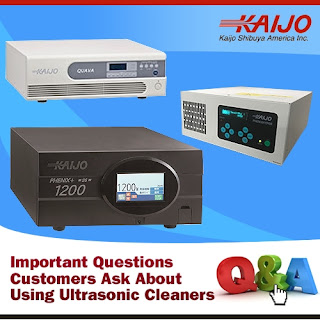Do you have questions about using
ultrasonic cleaners for your industrial cleaning application? Here are some
more of the important questions customers often ask about using Kaijo Shibuya's
industrial
ultrasonic cleaners and our answers.
1)
“Do I need to use a heater?”
It depends on your specific cleaning application. Ultrasonic cleaning systems do not normally use or require a heater but it can speed up the cleaning process.
2) “What does Sweep Mode do?”
As the ultrasonic waves spread through the cleaning tank, the parts to be cleaned interfere with the ultrasonic waves, creating spots where the waves become stronger and other areas where the waves become weaker. This can cause uneven cleaning. To avoid this, the sweep mode is used to automatically vary the ultrasonic frequency slightly, which causes the weak spots to move around. The result is a more even cleaning.
3) “Is the use of auto-tuning important?”
Yes, with auto-tuning the generator monitors and adjusts the power that is conducted to the transducer array. This allows the system to maintain the ideal calibration as the conditions change in the process tank during operation. This means any changes to temperature, water level, or chemical changes will not affect the power level in the cleaning tank.
4) “What ultrasonic frequency should I use?”
Low frequencies result in larger cavitation bubbles that deliver an intense cleaning action – you should use this type of frequency when you clean robust parts such as metal parts. High frequencies, on the other hand, result in comparatively smaller cavitation bubbles that deliver a less energetic cleaning action. You should use the lowest frequency that will not damage delicate the parts that are being cleaned.
It depends on your specific cleaning application. Ultrasonic cleaning systems do not normally use or require a heater but it can speed up the cleaning process.
2) “What does Sweep Mode do?”
As the ultrasonic waves spread through the cleaning tank, the parts to be cleaned interfere with the ultrasonic waves, creating spots where the waves become stronger and other areas where the waves become weaker. This can cause uneven cleaning. To avoid this, the sweep mode is used to automatically vary the ultrasonic frequency slightly, which causes the weak spots to move around. The result is a more even cleaning.
3) “Is the use of auto-tuning important?”
Yes, with auto-tuning the generator monitors and adjusts the power that is conducted to the transducer array. This allows the system to maintain the ideal calibration as the conditions change in the process tank during operation. This means any changes to temperature, water level, or chemical changes will not affect the power level in the cleaning tank.
4) “What ultrasonic frequency should I use?”
Low frequencies result in larger cavitation bubbles that deliver an intense cleaning action – you should use this type of frequency when you clean robust parts such as metal parts. High frequencies, on the other hand, result in comparatively smaller cavitation bubbles that deliver a less energetic cleaning action. You should use the lowest frequency that will not damage delicate the parts that are being cleaned.
Our recent article has additional
information for each of the questions above, as well as eight others. You can
read them by going to the complete article “Important
Questions Customers Ask About Using Ultrasonic Cleaners.”
If you have questions not included in the list, or if you would like to set up
a free consultation, call us at 408-675-5575 or send an email to info@kaijo-shibuya.com.


